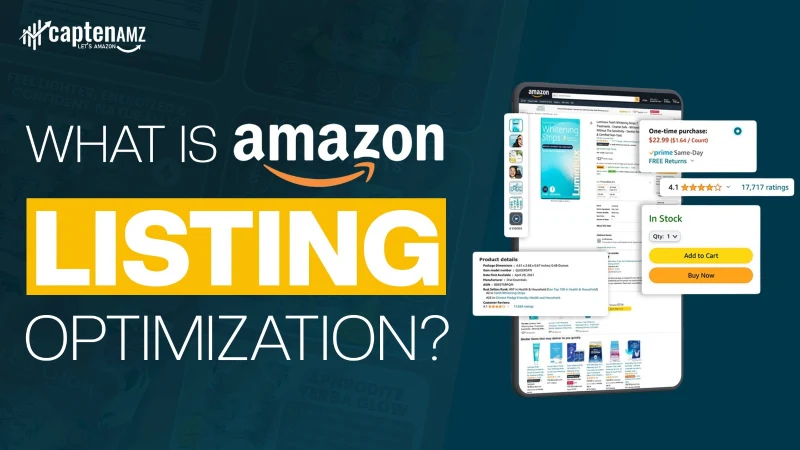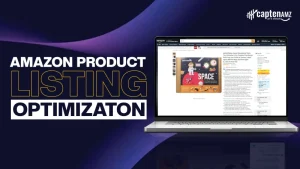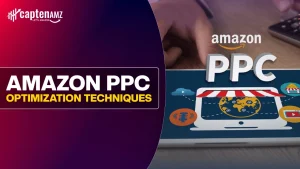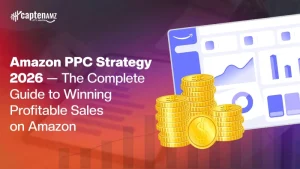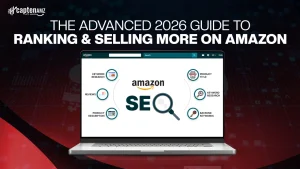Amazon listing optimization is the process of tuning every public and backend element of a product page so it ranks higher in Amazon search, converts more visitors into buyers, and stays compliant with Amazon policies. In 2026 the A10 algorithm increasingly rewards listings that combine accurate keyword signals, great conversion metrics, flawless catalog hygiene, and strong user experience. For FBA brands in competitive niches, Amazon listing optimization is no longer optional it’s the difference between page-one visibility and being buried.
In this guide, CaptenAMZ lays out a practical, market-tested framework you can use to optimize listings for SEO, CTR (click-through rate), and CVR (conversion rate). We cover keyword research, titles, bullets, A+ content, images, pricing strategy, backend search terms, advanced tactics for 2026, category-specific tips, and region-focused optimization for New York, New Jersey, Texas, California, and Florida.
Table of Contents
ToggleThe 7 Core Components of Amazon Listing Optimization (CaptenAMZ Framework)

CaptenAMZ’s unique 7-step Amazon listing optimization framework blends technical SEO, creative conversion copy, catalog hygiene, and PPC intelligence to create listings that both rank and sell.
1. Keyword Research for Maximum Visibility (Amazon Listing Optimization)
Great Amazon listing optimization starts with granular keyword research not just top keywords, but long-tail phrases, competitor terms, and backend variations that customers actually use.
- Primary keywords: High-volume purchase intent keywords (e.g., “wireless earbuds”).
- Long-tail keywords: Phrase queries that capture intent and reduce competition (e.g., “wireless earbuds with noise cancellation under $100”).
- Competitor keyword mining: Reverse-ASIN techniques reveal what terms top sellers rank for.
- Backend keyword strategy: Use backend search terms to cover spelling variants, synonyms, and non-visible phrases without repeating content already on the page.
Tools like Brand Analytics, Helium 10, and Jungle Scout help, but the difference is how you cluster and prioritize keywords for title, bullets, A+, and backend fields. CaptenAMZ uses advanced keyword clustering tuned to regional search patterns across New York, New Jersey, Texas, California & Florida for hyper-targeted ranking.
Also Read: Top 10 Amazon Tools Every Seller Must Use in 2025
2. High-Converting Amazon Product Title Optimization (Amazon Listing Optimization)
The product title is the single most important on-page SEO element for Amazon listing optimization. Follow this template: Brand + Main Keyword + Key Feature + Size/Qty + Important Attribute.
- A10 compliance: Keep titles within Amazon’s category-specific length and avoid promotional phrases.
- Keyword placement: Put the strongest keyword near the beginning, but keep it human and scannable.
- Brand credibility: Include the brand name for recognition and Brand Registry benefits.
- What NOT to include: Pricing, emojis, subjective claims (e.g., “best”), or prohibited terms.
Example (Good): “CaptenAMZ ProNoise Wireless Earbuds – Active Noise Canceling, 30HR Battery, Bluetooth 5.3 (Black)”
Example (Bad): “BEST Earbuds!!! Cheap Noise Cancelling – FREE SHIPPING”
3. Optimized Bullet Points for Conversion (Amazon Listing Optimization)
Bullets should turn features into benefits and answer buyer hesitations. For Amazon listing optimization, use 5 bullets that follow this structure: Feature → Benefit → Proof/Use-case.
- Features vs benefits: Convert technical specs into practical outcomes (e.g., “30HR battery” → “Listen all day no mid-flight charging”).
- NLP-based emotional hooks: Words like “comfort,” “confidence,” and “guarantee” increase persuasive power.
- Keyword inclusion: Sprinkle high-priority and mid-priority keywords naturally.
- Mobile-first formatting: Keep bullets concise (40–120 characters per line), bold the primary benefit in the opening clause.
CaptenAMZ writes bullets that reduce returns by clarifying fit, use-case, and materials decreasing mismatched expectations.
4. Product Description + A+ Content Optimization (Amazon Listing Optimization)
A+ Content (previously EBC) is where you tell the full brand story and increase conversions. This is a major lever in Amazon listing optimization.
- Narrative style: Use brief storytelling to explain why the product exists and who it’s for.
- HTML formatting: Use short paragraphs and line breaks where allowed to improve readability.
- Image modules & video modules: Show product-in-use videos and comparison charts.
- Internal linking in A+: Link to complementary SKUs (cross-sell) to increase basket size.
Visual storytelling and comparison charts can lift CVR significantly for competitive SKUs.
5. Product Images & Visual Optimization (Amazon Listing Optimization)
Images influence first impressions and conversion. The 7–9 image rule is standard; follow it:
- Main image: White background, product fills 85% of the frame.
- Lifestyle images: Show the product in real use, scaled correctly.
- Infographics: Highlight 3–5 key features visually.
- Compliance checklist: No promotional text on the main image, no misleading overlays.
For high-ticket categories, visuals matter even more. CaptenAMZ provides Amazon product photoshoot guidance for U.S. sellers to ensure creative assets meet both Amazon rules and conversion best practices.
6. Price, Offers & Deals Optimization (Amazon Listing Optimization)
Pricing and promotions massively affect conversion and buy box win-rate. For Amazon listing optimization:
- Pricing psychology: Round prices, use charm pricing only where it fits the niche.
- Coupons & deals: Use sparingly but strategically during launch windows and seasonal bursts.
- Buy Box impact: Ensure competitive pricing, FBA fulfillment, and low defect rates to maintain Buy Box performance.
Offers should be coordinated with PPC and Organic efforts a price drop without promotional plan can drain margins.
7. Backend Search Terms Optimization (Amazon Listing Optimization)
Back-end fields are essential to capture additional search queries. Best practices:
- What to add: Spelling variants, alternate names, key materials, and model numbers.
- What NOT to add: Repeated keywords already on the listing, competitor brand names, or prohibited claims.
- Common mistakes: Using commas (Amazon ignores them), overstuffing, and exceeding character limits.
The A10 algorithm evaluates relevancy and performance signals well-structured backend terms support long-tail indexing and help your listing appear for related queries.
Advanced Listing Optimization Strategies (2025 Prime Edition)

1. Using Competitor Data to Improve Your Listing (Amazon Listing Optimization)
Reverse ASIN, review mining, and competitor gap analysis reveal untapped opportunities. Extract emotional keywords from reviews (positive phrases and pain points) and incorporate them into bullets and A+ to capture buyer sentiment.
2. Review Optimization & Social Proof Boosting (Amazon Listing Optimization)
Reviews affect CTR and CVR. Use compliant review request sequences, enroll best-suited SKUs in programs (Vine or Early Reviewer alternatives), and perform sentiment analysis to craft content addressing common objections.
3. Listing SEO + PPC Integration (CaptenAMZ Advantage – Amazon Listing Optimization)
PPC drives impressions and click signals that accelerate organic ranking when used strategically:
- Auto-campaign mining: Harvest high-converting search terms and convert them into manual campaigns and listing copy.
- Keyword harvesting: Use ad data to validate or remove keywords from your listing.
- CTR signals: Ads that lift CTR can also signal relevance to A10.
This integration is a core CaptenAMZ advantage, PPC intelligence informs SEO changes for rapid ranking gains across NY, NJ, TX, CA & FL markets.
Common Amazon Listing Optimization Mistakes (And How to Avoid Them)
- Keyword stuffing: Harms readability and may reduce conversions, prioritize relevance.
- Irrelevant images: Confuse buyers and increase returns.
- Non-compliant titles: Risk suppression or warnings from Amazon.
- Weak bullet points: Missed opportunities to address objections.
- Missing backend keywords: Lose long-tail traffic.
- No A+ content: Missing out on conversion uplift for branded listings.
- No pricing strategy: Weak buy box odds and low CVR.
- Using low-volume keywords only: Limits scale.
Fix these with a systematic checklist and weekly QA audits.
How to Optimize Amazon Listing for SEO, CTR & CVR (CaptenAMZ Method)
A step-by-step workflow for Amazon listing optimization:
- Audit: Run a technical SEO + creative audit (keywords, images, A+, backend).
- Prioritize: Score issues by sales impact and fix revenue-leading problems first.
- Keyword map: Assign primary, secondary, and backend keywords to title, bullets, A+, and backend.
- Creative rollout: Update images and videos in a staging plan and A/B test where possible.
- PPC seeding: Run targeted PPC campaigns to validate keywords and accelerate indexing.
- Monitor & iterate: Weekly performance checks for CTR, CVR, ACoS, search rank, and reviews.
- Scale: Apply winning templates across similar SKUs and categories.
This workflow reduces risk and ensures changes are data-driven.
Category-Specific Listing Optimization Tips
Different categories require different emphasis for Amazon listing optimization.
Beauty & Personal Care
- Highlight ingredients and safety.
- Include compliance disclaimers.
- Use close-up texture images.
Home & Kitchen
- Focus on dimensions and compatibility.
- Lifestyle images showing scale are crucial.
Fitness & Sports
- Emphasize durability and material show action shots.
- Include weight limits and certifications.
Electronics
- List precise specs first; add compatibility charts.
- Use tech-focused infographics and FAQ sections.
Supplements
- Prioritize compliance: ingredient list, dosage, and certifications.
- Avoid health claims stick to structure/function where allowed.
Providing category-specific content is a major differentiator and helps capture high-intent buyers.
Localized Optimization for U.S. Regions (CaptenAMZ Specialization)
CaptenAMZ works with sellers across New York (Manhattan + Hamptons), New Jersey, Texas, California, and Florida. Regional optimization matters: search intent, seasonality, and imagery preferences can vary by market.
- NYC / Hamptons: Luxury and lifestyle imagery perform well for premium products.
- New Jersey: Competitive commuter markets favor compact, practical features.
- Texas: Value + durability appeals in larger, outdoor-oriented households.
- California: Sustainability claims and eco-friendly visuals resonate.
- Florida: Bright, seasonal imagery and travel-ready features often convert better.
Tailor keywords and visuals to reflect regional language, cultural preferences, and functional needs.
Amazon Listing Optimization Tools (Recommended List)

- Helium 10 – keyword research, listing optimization, and alerts.
- Jungle Scout – market intelligence and product research.
- SellerApp – keyword and PPC insights.
- DataDive – category analytics and trend spotting.
- CaptenAMZ Listing Optimization Service – our managed solution that combines these tools with expert execution and U.S. region-specific optimization.
Use tools to scale research, but rely on human judgment and A/B testing for final copy and creative decisions.
When Should You Update or Re-Optimize Your Listing?
Re-optimize when:
- New competitors enter the niche.
- Sales drop or Buy Box loss occurs.
- Seasonality shifts demand.
- PPC campaigns underperform or ACoS balloons.
- Review sentiment changes or negative trends emerge.
A schedule: quick weekly checks, monthly audit, and a deeper quarterly refresh for evergreen listings.
How CaptenAMZ Helps You Optimize Your Amazon Listings
CaptenAMZ provides end-to-end Amazon listing optimization services:
- Amazon SEO – keyword research, title & bullet rewriting.
- Listing content creation – bullets, A+, and localized descriptions.
- PPC Management – campaign structure, keyword harvesting, and integration with SEO.
- Catalog Management – flat-file fixes, variation sanitization, and suppression recovery.
- A+ Content – visual storytelling and comparison modules.
- Competitor tracking & keyword clustering – continuous market intelligence.
- Compliance checks & documentation – minimize suppression risk.
- U.S. region-specific optimization – targeted language, imagery, and keyword sets for NY, NJ, TX, CA & FL.
Our clients benefit from coordinated SEO + PPC plans that drive immediate traction and sustainable organic growth.
FAQs
How do I optimize my Amazon listing?
Start with keyword research, write a focused title, create benefit-led bullets, upload compliant images, add A+ content, and optimize backend search terms. Test changes and coordinate with PPC.
How long does Amazon SEO take?
Initial improvements often show in 2–6 weeks, but meaningful organic ranking gains typically take 2–4 months depending on competition and ad support.
Why is my listing not ranking?
Common causes: poor keyword targeting, low CTR, weak conversion rate, suppressed attributes, or poor catalog hygiene.
How many keywords should I add?
Map 3–6 primary keywords to visible fields and use backend terms for long-tail and variants. Quality and intent > quantity.
Does PPC improve listing ranking?
Yes, strategic PPC can accelerate indexing and provide behavioral signals (CTR, conversion) that help the A10 algorithm recognize relevance.
Wrapping up
Amazon listing optimization is a continuous, data-driven process that combines keyword strategy, persuasive copy, world-class visuals, and technical catalog discipline. Brands that treat listing optimization as an ongoing system not a one-time task see better rankings, higher CTR, and stronger conversions.
If you want a fully optimized Amazon listing that ranks higher, converts better, and beats your competition, CaptenAMZ offers done-for-you Amazon listing optimization, PPC management, SEO, and catalog services across New York, New Jersey, Texas, California & Florida. See us on LinkedIn & Instagram.
Book your Free Listing Audit with CaptenAMZ now | we’ll deliver a prioritized optimization plan, competitor gap analysis, and a 90-day growth roadmap tailored to your SKUs.

